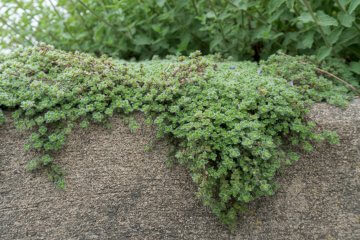

The origin of its name is derived from the Greek word thumos which means courage. Due to its natural antibacterial properties, bandages were soaked in thyme oil to assist the healing process. Ancient Egyptians used it for embalming, Greeks burned it as incense, and Romans for flavoring cheese and liqueurs. Thyme has been used for centuries as food, medicine, and fragrance. Flowers are tiny and tubular, and act as a magnet for bees and butterflies. The attractive foliage is highly fragrant, especially just before plants begin to flower.įrom May to July, thyme bears masses of pretty blooms in white, pink, or lavender hues. It’s indigenous to southern Europe and northern Africa and favors the dry, rocky soils of the Mediterranean.įorming mounds 6 to 12 inches tall, thyme’s woody stems are clad in small pointed gray-green leaves. About ThymeĬommon thyme ( Thymus vulgaris) is a woody, perennial, evergreen herb in the mint family. Flavor-wise, it lands somewhere between lavender and rosemary.įor many, thyme perfectly encapsulates the fragrance of summertime. Moisture: D = dry M = Moist We = wet Wa = water.The aroma of thyme is pleasant and complex – peppery and a little sweet with woody, earthy, minty and flowery notes.
#WOOLLY THYME FULL#
Shade: F = full shade S = semi-shade N = no shade. pH: A = acid N = neutral B = basic (alkaline). Soil: L = light (sandy) M = medium H = heavy (clay). Lemon Thyme, Creeping Lemon Thyme, Lemon-Scented Thyme IUCN Red List of Threatened Plants Status : Please note that a plant may be invasive in one area but may not in your area so it’s worth checking. If available other names are mentioned hereĬountries where the plant has been found are listed here if the information is available Cuttings of half-ripe wood, 5 - 8cm with a heel, July/August in a frame. Cuttings of young shoots, 5 - 8cm with a heel, May/June in a frame. Plant them out in the summer or the following spring.

We have found that it is best to pot up smaller divisions and grow them on in light shade in a greenhouse or cold frame until they are growing away well. Larger divisions can be planted out direct into their permanent positions. Plant them out into their permanent positions in late spring or early summer, after the last expected frosts. When they are large enough to handle, prick the seedlings out into individual pots and grow them on in the greenhouse for at least their first winter. Seed can also be sown in autumn in a greenhouse. Our new book to be released soon is Edible Shrubs. Book titles include Edible Plants, Edible Perennials, Edible Trees, and Woodland Gardening. Plants For A Future have a number of books available in paperback and digital form. Type a value in the Celsius field to convert the value to Fahrenheit: References Carbon Farming Information and Carbon Sequestration Information Temperature Converter Special Features:Attractive foliage, Edible, Fragrant foliage. There are some named varieties selected for culinary and ornamental purposes. This is a very difficult genus taxonomically, the species hybridize freely with each other and often intergrade into each other. The flowers are rich in nectar and are very attractive to honey bees. A layer of gravel on the soil around them will help protect the foliage from wet soils. Thymes dislike wet conditions, especially in the winter. Grows well between stepping stones on paths, tolerating light treading. Requires a light well-drained preferably calcareous soil in a sunny position. Landscape Uses:Border, Container, Ground cover, Rock garden.


 0 kommentar(er)
0 kommentar(er)
